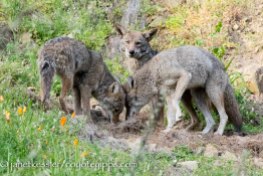Dad expels food for yearling youngsters — Dad is to the left in all these photos
Coyote pups were born at the end of March and the beginning of April this year here in San Francisco, so they are now four to six weeks old. To begin with, all pups are fed with their mother’s milk. Depending on the mother coyote and her age, this is either obvious or not so much so, as you can see in these photos.
Lactating mothers
As the pups grow, soft food is introduced into the youngsters’ diet. Regurgitated food is what young coyotes are fed as they are weaned off of their early milk diet. Eventually more solid forms of food are introduced: first, parts of and then whole dead rodents, then incapacitated prey, and finally live prey is brought home for the youngsters to learn to deal with and eat.
The youngsters depicted in these photos here were born last year. They appear to still be enjoying an extended puppyhood, even as their mother has gone off to give birth to a new litter. Uninhibited play and fun are still the order of the day for them. Interestingly, they are still receiving presents in the way of food from Dad.
A yearling youngster elicits the regurgitation reflex in his father before a sibling joins him as Dad watches
Upon seeing Dad, the most exuberant and active youngster of the litter runs to greet Dad and thrusts his snout into Dad’s mouth which elicits a regurgitation response. I don’t know if the regurgitation is actually voluntary or an involuntary response. This sort of feeding and being fed keeps everyone in their same states of dependence (for the youngsters) or leadership (for Dad), and is a strong solidifier of bonds and affection.
This particular family was a large one, with seven youngsters being born last year. This is the largest litter I have ever seen here in the city, with most litters being one, two, or three youngsters. But this litter is now down to four. One youngster was killed by a car, and two more were found dead. Although I haven’t found out what those two died of, I can pretty safely assume it was rat-poison or less likely, a natural disease. Coyote pup survival rate is only 20-30%, which, by the way, is actually higher than some human infant survival rates in Africa today where infant mortality is 92% in some villages.
A little about this family: of the four youngsters who survive, there are three rough-and-tumble youngsters — a female and two males — who throw themselves fully into their interactions and play. One of the males is the outstanding activist in the family. Then there is a smaller gal, a loner, who doesn’t appear to like the rough play of the others, nor the competition. And I’ve noticed that she doesn’t hurry over to partake in the regurgitated food her father proffers. In fact, that might be why she is comparatively smaller than the others. Coyotes have innate and very individual personalities which, just like with us humans, are further developed through each coyote’s individual place in the family and the feedback they constantly receive.














May 18, 2018 @ 05:31:29
Oh this story tugs on my heart strings in soooo many ways. Thank you,
May 18, 2018 @ 11:58:54
They are really fun and interesting, aren’t they!